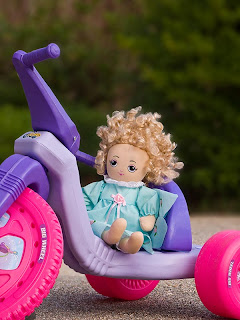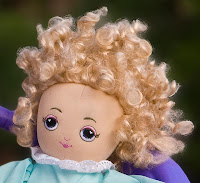. .jpg)
As noted in previous postings, the G9 and similar digicams tend to produce photographs with deep depth of field whereas sometimes a blurry background helps to emphasize the subject. If the background is not sufficiently blurred in-camera then Photoshop or similar programs can be used to increase the blur.
This is the same photo of Hannah as previous shown except that Photoshop was used to increase the background blur. In the past, I’ve blurred the background in Photoshop by simply making a duplicate layer, blurring that entire layer and then creating a mask to hide or show the appropriate sections. More recently, I’m learning to use the Lens Blur Filter in Photoshop CS4 (Filter, Blur, Lens Blur in the menu). For this photo, I used an Alpha Channel to make a depth map and – tediously, I might add – attempted to paint a mask of varying distances. For web viewing, the result is OK but certainly not great.
.jpg) An editing problem is differentiating the background from fine details such as Hannah’s hair. Differentiating fine details from the background is tedious and requires much patience. I tried several variations of selecting and masking. This cropped section illustrates the differences between rough (OK, impatient) masking and somewhat more careful masking.
An editing problem is differentiating the background from fine details such as Hannah’s hair. Differentiating fine details from the background is tedious and requires much patience. I tried several variations of selecting and masking. This cropped section illustrates the differences between rough (OK, impatient) masking and somewhat more careful masking.
I won’t even try to describe how to make the depth map but here are some links to instructions from others
http://www.computer-darkroom.com/tutorials/tutorial_9_1.htm
http://www.outbackphoto.com/workflow/wf_51/essay.html
http://photography-on-the.net/forum/showthread.php?t=102294
After using Photoshop to blur the background in pictures taken with my G9, I’ve resolved to use a different camera whenever the subject and scene call for a blurry background!
.
.jpg)
As noted in previous postings, the G9 and similar digicams tend to produce photographs with deep depth of field whereas sometimes a blurry background helps to emphasize the subject. If the background is not sufficiently blurred in-camera then Photoshop or similar programs can be used to increase the blur.
This is the same photo of Hannah as previous shown except that Photoshop was used to increase the background blur. In the past, I’ve blurred the background in Photoshop by simply making a duplicate layer, blurring that entire layer and then creating a mask to hide or show the appropriate sections. More recently, I’m learning to use the Lens Blur Filter in Photoshop CS4 (Filter, Blur, Lens Blur in the menu). For this photo, I used an Alpha Channel to make a depth map and – tediously, I might add – attempted to paint a mask of varying distances. For web viewing, the result is OK but certainly not great.
.jpg) An editing problem is differentiating the background from fine details such as Hannah’s hair. Differentiating fine details from the background is tedious and requires much patience. I tried several variations of selecting and masking. This cropped section illustrates the differences between rough (OK, impatient) masking and somewhat more careful masking.
An editing problem is differentiating the background from fine details such as Hannah’s hair. Differentiating fine details from the background is tedious and requires much patience. I tried several variations of selecting and masking. This cropped section illustrates the differences between rough (OK, impatient) masking and somewhat more careful masking.I won’t even try to describe how to make the depth map but here are some links to instructions from others
http://www.computer-darkroom.com/tutorials/tutorial_9_1.htm
http://www.outbackphoto.com/workflow/wf_51/essay.html
http://photography-on-the.net/forum/showthread.php?t=102294
After using Photoshop to blur the background in pictures taken with my G9, I’ve resolved to use a different camera whenever the subject and scene call for a blurry background!
.
1 comment:
Cute doll...
Post a Comment